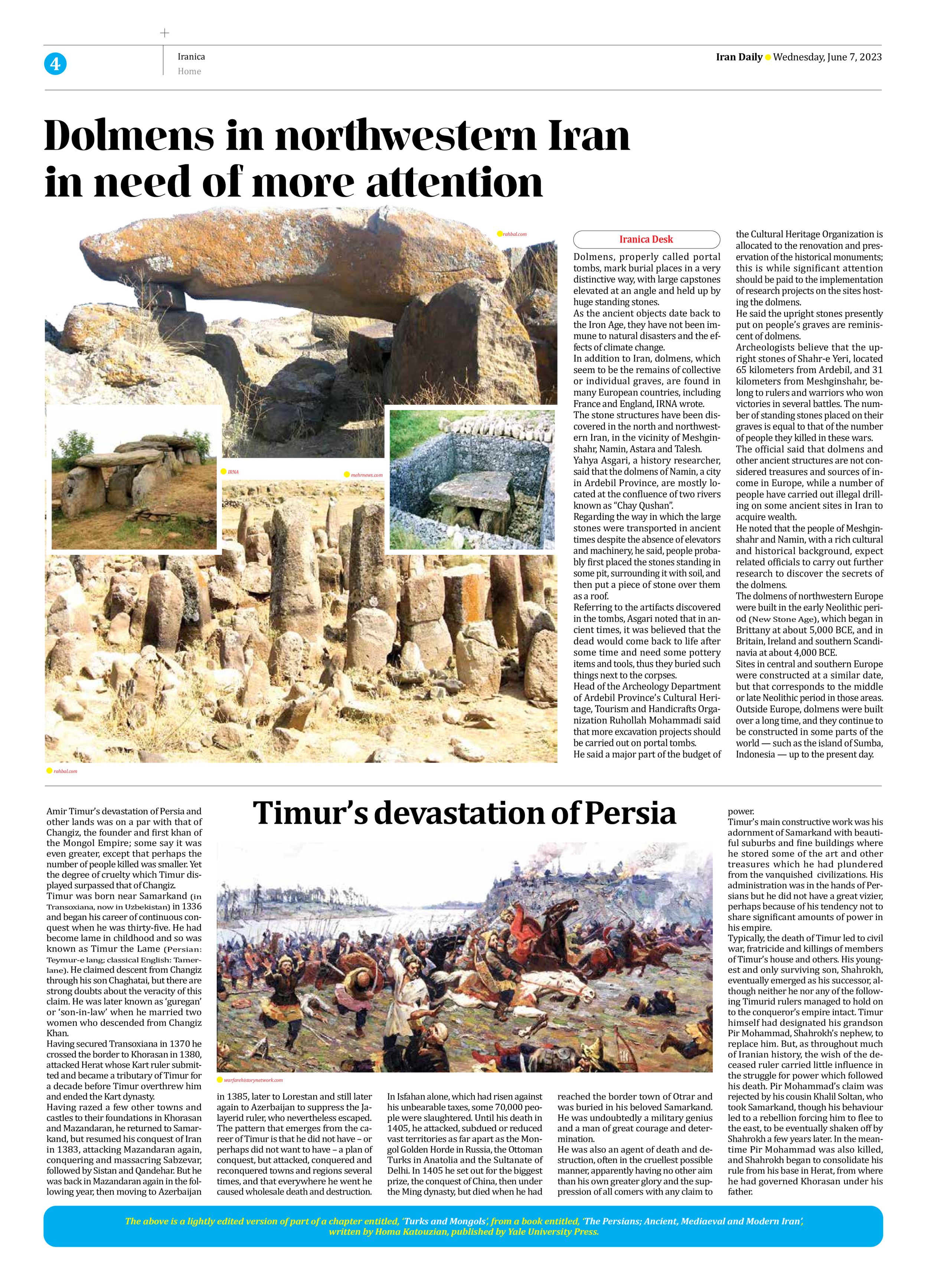
Timur’s devastation of Persia
Amir Timur’s devastation of Persia and other lands was on a par with that of Changiz, the founder and first khan of the Mongol Empire; some say it was even greater, except that perhaps the number of people killed was smaller. Yet the degree of cruelty which Timur displayed surpassed that of Changiz.
Timur was born near Samarkand (in Transoxiana, now in Uzbekistan) in 1336 and began his career of continuous conquest when he was thirty-five. He had become lame in childhood and so was known as Timur the Lame (Persian: Teymur-e lang; classical English: Tamerlane). He claimed descent from Changiz through his son Chaghatai, but there are strong doubts about the veracity of this claim. He was later known as ‘guregan’ or ‘son-in-law’ when he married two women who descended from Changiz Khan.
Having secured Transoxiana in 1370 he crossed the border to Khorasan in 1380, attacked Herat whose Kart ruler submitted and became a tributary of Timur for a decade before Timur overthrew him and ended the Kart dynasty.
Having razed a few other towns and castles to their foundations in Khorasan and Mazandaran, he returned to Samarkand, but resumed his conquest of Iran in 1383, attacking Mazandaran again, conquering and massacring Sabzevar, followed by Sistan and Qandehar. But he was back in Mazandaran again in the following year, then moving to Azerbaijan in 1385, later to Lorestan and still later again to Azerbaijan to suppress the Jalayerid ruler, who nevertheless escaped.
The pattern that emerges from the career of Timur is that he did not have – or perhaps did not want to have – a plan of conquest, but attacked, conquered and reconquered towns and regions several times, and that everywhere he went he caused wholesale death and destruction. In Isfahan alone, which had risen against his unbearable taxes, some 70,000 people were slaughtered. Until his death in 1405, he attacked, subdued or reduced vast territories as far apart as the Mongol Golden Horde in Russia, the Ottoman Turks in Anatolia and the Sultanate of Delhi. In 1405 he set out for the biggest prize, the conquest of China, then under the Ming dynasty, but died when he had reached the border town of Otrar and was buried in his beloved Samarkand. He was undoubtedly a military genius and a man of great courage and determination.
He was also an agent of death and destruction, often in the cruellest possible manner, apparently having no other aim than his own greater glory and the suppression of all comers with any claim to power.
Timur’s main constructive work was his adornment of Samarkand with beautiful suburbs and fine buildings where he stored some of the art and other treasures which he had plundered from the vanquished civilizations. His administration was in the hands of Persians but he did not have a great vizier, perhaps because of his tendency not to share significant amounts of power in his empire.
Typically, the death of Timur led to civil war, fratricide and killings of members of Timur’s house and others. His youngest and only surviving son, Shahrokh, eventually emerged as his successor, although neither he nor any of the following Timurid rulers managed to hold on to the conqueror’s empire intact. Timur himself had designated his grandson Pir Mohammad, Shahrokh’s nephew, to replace him. But, as throughout much of Iranian history, the wish of the deceased ruler carried little influence in the struggle for power which followed his death. Pir Mohammad’s claim was rejected by his cousin Khalil Soltan, who took Samarkand, though his behaviour led to a rebellion forcing him to flee to the east, to be eventually shaken off by Shahrokh a few years later. In the meantime Pir Mohammad was also killed, and Shahrokh began to consolidate his rule from his base in Herat, from where he had governed Khorasan under his father.
The above is a lightly edited version of part of a chapter entitled, ‘Turks and Mongols’, from a book entitled, ‘The Persians; Ancient, Mediaeval and Modern Iran’,
written by Homa Katouzian, published by Yale University Press.







